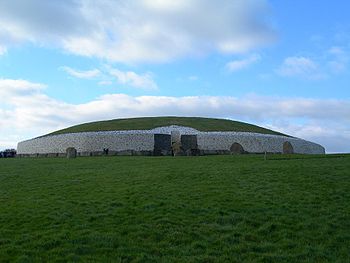Brú na Bóinne: Difference between revisions
| Line 47: | Line 47: | ||
{{Catself}} | {{Catself}} | ||
[[Category:Prehistoric Meath]] | [[Category:Prehistoric Meath]] | ||
[[Category:World Heritage Sites in the Republic of Ireland]] | |||
Revision as of 22:39, 13 November 2014

Brú na Bóinne (pronounced ˈbˠɾˠuː n̪ˠə ˈbˠoːn̪ʲə) is a World Heritage Site in Meath in the Republic of Ireland and is the largest and one of the most important complex of Megalithic sites in Europe, dating to the Neolithic period. The complex is situated around a wide bend in the River Boyne. The name given to it today, Brú na Bóinne, means Palace of the Boyne".
The site
The site is a complex of Neolithic mounds, chamber tombs, standing stones, henges and other prehistoric enclosures, some from as early as 35th century BC - 32nd century BC. The site predates the Egyptian pyramids and was built with sophistication and a knowledge of science and astronomy, which is most evident in the passage grave of Newgrange. The site is in a bend in the River Boyne. The associated archaeological culture is often called the Boyne culture.
The site covers 1,927 acres and contains around 40 passage graves, as well as other prehistoric sites and later features.
The majority of the monuments are concentrated on the north side of the river. The most well-known sites within Brú na Bóinne are the impressive passage graves of Newgrange, Knowth and Dowth, all famous for their significant collections of megalithic art. Each stands on a ridge within the river bend and two of the tombs, Knowth and Newgrange, appear to contain stones re-used from an earlier monument at the site. There is no in situ evidence for earlier activity at the site, save for the spotfinds of flint tools left by Mesolithic hunters.
However, there is evidence that the site was visited repeatedly during the Bronze, Iron and Medieval periods, evidenced by the multiple Beaker, Roman, and mediæval artefacts that were found during O'Kelly's excavations from 1962 to 1975.
Numerous other enclosure and megalith sites have been identified within the river bend and have been given simple letter designations, such as the M Enclosures. In addition to the three famous tombs, several other ceremonial sites constitute the complex including:
- Cloghalea Henge
- Townleyhall passage grave
- Monknewtown henge and ritual pond
- Newgrange cursus
Newgrange is the central mound of the Boyne Valley passage grave cemetery, but many other passage graves exist in the environs, including Knowth and Dowth which are of comparable size to Newgrange. Each of the three main megalith sites have significant archaeoastronomical significance. Newgrange and Dowth have Winter solstice solar alignments, while it is claimed Knowth has an Equinox solar alignment. In addition, the immediate environs of the main sites have been investigated for other possible alignments. The layout and design of the Brú na Bóinne complex across the valley has also been studied for astronomical significance.
As well as being surrounded on its southern, western and eastern sides by the Boyne, one of the Boyne's tributaries, the Mattock, runs along the northern edge, almost completely surrounding Brú na Bóinne with water. All but two of the prehistoric sites are within this river isthmus.
Brú na Bóinne Visitor Centre
All access to Newgrange and Knowth is by guided tour only: tours begin at the Visitor Centre in Donore, Meath.
Outside links
- UNESCO's World Heritage Site description
- Heritage Ireland: Visitor Centre
- Boyne Valley Portal
- Martin Byrne's Newgrange pages
- Newgrange.com
- Knowth.com
References
- Lewis-Williams, D and Pearce, D, Inside the Neolithic Mind, Thames and Hudson, London, 2005, ISBN 0-500-05138-0
- O'Kelly, M. J., 1982. Newgrange: archaeology, art, and legend, London: Thames and Hudson, Ltd.
Coordinates: 53°41′34″N 6°26′58″W / 53.69284°N 6.44932°W
| World Heritage Sites in the Republic of Ireland |
|---|
|
Brú na Bóinne: Dowth • Knowth • Newgrange • Monknewton • Newgrange cursus • Townleyhall passage grave • |